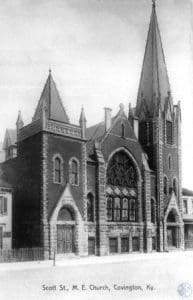Community History - Covington - Scott Street M.E. South (First M.E. Church South)
 A Methodist society was established in Covington in 1827 with 10 members. By 1832, the number had grown to 195. That year, the Methodists financed the construction of a church at 233-235 Garrard Street. This original building was quickly replaced by a larger structure in 1843. This building was located on the east side of Scott Street between 5th and 6th Street. The congregation was named Scott Street Methodist Episcopal Church. The energetic congregation raised funds to construct a façade to the 1843 building. This work amounted to $8,000 and was raised in a two-day period.
A Methodist society was established in Covington in 1827 with 10 members. By 1832, the number had grown to 195. That year, the Methodists financed the construction of a church at 233-235 Garrard Street. This original building was quickly replaced by a larger structure in 1843. This building was located on the east side of Scott Street between 5th and 6th Street. The congregation was named Scott Street Methodist Episcopal Church. The energetic congregation raised funds to construct a façade to the 1843 building. This work amounted to $8,000 and was raised in a two-day period.
Like many other Protestant denominations, the Methodist Episcopal Church in the United States fragmented over the issue of slavery. In 1844, a separate organization called the Methodist Episcopal Church South was established. In 1846, the members of the Scott Street M.E. Church voted to affiliate with the Methodist Church South. The 27 members who cast dissenting votes left the congregation. These 27 members formed the nucleus of the new Union Methodist Episcopal Church at Greenup and 5th Streets.
In 1878, the congregation began a mission church on 11th Street between Madison and Scott Streets. The congregation became known as 11th Street Methodist Episcopal Church South. In 1912, the 11th Street congregation built at new edifice at the corner of Greenup and 18th Streets. At that time, the name of the church was changed to St. Luke Methodist Episcopal Church South.
The members of the Scott Street Church decided to construct a larger building in 1895. The congregation hired the Cincinnati architectural firm of Crapsey and Brown to design a new edifice. The cornerstone of the new building was set into place on June 30, 1895. The dedication ceremonies occurred in May 1896. The new Scott Street Methodist Episcopal Church was a Victorian Gothic Style structure with a façade featuring corner bell towers surmounted by spires. Each tower contained a entryway into the building. The central portion of the façade contained a large stained glass window. The building measured 110’ in length and 68 ½’ in width and had a seating capacity of 1,200.
Tragedy struck the congregation in January 1904. A fire with its origins in the basement of the church quickly spread. To make matters worse, the extremely cold temperatures resulted in several water mains freezing. By the time the fire was extinguished, much damage had been done to the building. Several of the memorial stained glass windows and the pipe organ were completely destroyed. A restoration of the building was quickly undertaken.
The neighborhood around Scott Street M.E. Church slowly changed during the World War I era. The area became less residential and more commercial. As a result, membership in the congregation began to decline. In 1928 a decision was made to merge Scott Street M.E. and St. Luke M.E. under the name First M.E. Church South. The merger process, however, did not go smoothly. In 1930, the merger was abandoned. The Scott Street M.E. congregation continued to worship in their historic structure under the title First M.E. Church South.
In 1939 the Methodist Episcopal Church and the Methodist Episcopal South Church decided to merge. Soon thereafter, the members of the Union Methodist Episcopal Church and First Methodist Episcopal South Church also decided to merge. The merger became effective in September 1939. The merged congregation retained the old Union M.E. Church at Greenup and 5th Streets. The old Scott Street building was rented to the First Church of the Nazarene (this congregation purchased the building from the Methodists in 1944). In 1967, the Nazarenes built a new church on the Dixie Highway in Park Hills. The Scott Street church stood vacant for a number of years and was eventually demolished in 1970 to make way for the new Kenton County Public Library.
Paul A. Tenkotte, A Heritage of Art and Faith: Downtown Covington Churches (Covington: Kenton County Historical Society) 1986, pp. 43-49; Licking Valley Register, July 8, 1843; Covington Journal, February 8, 1868, p. 3; Kentucky Post, April 1, 1895, p. 2, June 3, 1895, p. 4, May 12, 1896, p. 7, May 18, 1896, p. 5, January 4, 1904, p. 1, January 18, 1904, p. 5 and November 11, 1928, p. 1.
